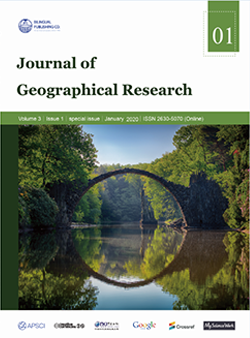-
1423
-
376
-
295
-
230
-
190
Applications in New River-meander Model
DOI:
https://doi.org/10.30564/jgr.v3i1.1896Abstract
If the sediment transport behaves as bed-load, the sediment surface at meandering channel will deform into transverse waves.This investigation is a new model for prediction of river-meander models in nature.The aim of this research is to give a precise method whose bed forms can have a variety of scales ranging from ripples through small dunes to fully developed dunes or sandwaves.Its mathematical model will be investigated.Keywords:
Sand waves; Sediment; Meandering; TransportationReferences
[1] Sediment. Transportation Mechanics: Introduction and properties of Sediment. Task Committee on preparation of Sedimentation, Manual of the Committee on Sedimentation, Vita A. Vanoni, Journal of the Hydraulics Division, ASCE, Paper 3194, 1962,88(Hy 4): 77-107.
[2] Yilmaz, L.. Stochastic Sedimentation Process Distribution at Particle Energy. Nisantasi University,1453,Neocampus, Istanbul, Turkey, (unpublished research) 2019.
[3] Blondeaux, P., Seminara, G.. A unified bar-bend theory of river meanders. J. Fluid Mech., 1985,157:449-470.
[4] Chitale, S. V.. River channel patterns. J.Hydr.Div.,ASCE, 1970, 96(1): 201-222.
[5] Dietrich, W.E., Smith, J. D.. Influence of the point bar on flow through curved channels. Water Resour.Res., 1983, 19(5): 1173-1192.
[6] Ikeda, S.. Prediction of alternate bar wavelength and height. J. Hydr. Engrg., ASCE, 1984, 110(4):371-386.
[7] Ikeda, S., Parker, G., Sawai, K.. Bend theory of river meanders. Part 1. Linear development. J.Fluid Mech., 1981, 112: 363 - 377.
[8] Kitanidis, P. K., Kennedy, J.F.. Secondary current and river-meander formation. J. Fluid Mech.,1984,114: 217-229.
[9] Odgaard, A. J.. Bank erosion contribution to stream sediment load. IIHR Report No. 280, Iowa Inst.of Hydr. Res., The Univ. of Iowa, Iowa City, Iowa,1984.
[10] Odgaard, A. J.. Meander flow model. I: Development. J. Hydr. Engrg., ASCE, 1986a, 112(12):1117-1136.
[11] Odgaard, A. J.. Meander flow model. II: Applications. J. Hydr. Engrg., ASCE, 1986b, 112(12):1137-1150.
[12] Odgaard, A. J.. Streambank erosion along two rivers in Iowa. Water Resour. Res., 1987, 23(7):1225-1236.
[13] Odgaard, A. J.. River Meander model. I: Development. J. Hydr. Engrg., ASCE, 1989, 115(11):1433-1450.
[14] Osman, A. M. , Thorne, C.R.. Riverbank stability analysis. I: Theory. J. Hydr. Engrg., ASCE,1988,114(2): 134-150.
[15] Thorne, C.R., Osman, A.M.. Riverbank stability analysis. II: Applications. J. Hydr. Engrg., ASCE,1988,114(2): 151-172.
[16] Yilmaz, L.. Irrigation and Drainage Management,Chapter 11. Hydraulic Geometry: Ramette’s Work Maximum Sediment Discharge and Froude Number Hypothesis, Studium Press, P.O. Box 722200, Houston, Texas 77072, USA, 2012: 142-154.
[17] U.S. Army Corps of Engineers.. The Streambank Erosion Control Evaluation and Demonstration Act of 1974. Section 32, Public Law 93-251. Final report to the U.S. Congress, Waterways Experiment Station,Vicksburg, Miss, 1981.
Downloads
How to Cite
Issue
Article Type
License
Copyright © 2020 Levent Yilmaz

This is an open access article under the Creative Commons Attribution-NonCommercial 4.0 International (CC BY-NC 4.0) License.




 Levent Yilmaz
Levent Yilmaz





